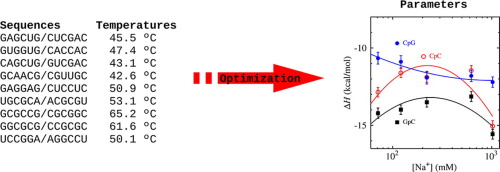当前位置:
X-MOL 学术
›
Chem. Phys.
›
论文详情
Our official English website, www.x-mol.net, welcomes your
feedback! (Note: you will need to create a separate account there.)
Replacing salt correction factors with optimized RNA nearest-neighbour enthalpy and entropy parameters.
Chemical Physics ( IF 2.0 ) Pub Date : 2019-01-17 , DOI: 10.1016/j.chemphys.2019.01.016 Izabela Ferreira 1 , Elizabeth A Jolley 2 , Brent M Znosko 2 , Gerald Weber 1
Chemical Physics ( IF 2.0 ) Pub Date : 2019-01-17 , DOI: 10.1016/j.chemphys.2019.01.016 Izabela Ferreira 1 , Elizabeth A Jolley 2 , Brent M Znosko 2 , Gerald Weber 1
Affiliation

|
We calculate the nearest-neighbour enthalpies and entropies at 5 salt concentrations of 18 RNA sequences, each for at least 9 different species concentrations, totalling 757 melting temperatures, using a melting temperature optimization method. These new parameters do not need to be salt-corrected and are shown to provide overall improved melting temperature predictions. They show a marked quadratic dependence with salt concentrations which are compensated to form linear Gibbs free energies. Two different parameter schemes were tested, with fixed or variable initial parameters. We have found that using variable initial parameters provides better predictive results than using salt correction factors and that the prediction uncertainty is considerably reduced for a validation set of independent sequences. An interpolation scheme is introduced to generate model parameters for arbitrary salt concentrations which performs better against a validation set than predictions using salt corrections.
中文翻译:

用优化的RNA最近邻焓和熵参数代替盐校正因子。
我们使用熔解温度优化方法,计算了18种RNA序列的5种盐浓度下的最近邻焓和熵,每种盐浓度至少9种不同的物种浓度,总计757熔解温度。这些新参数不需要进行盐校正,并且可以提供总体上改善的熔融温度预测。它们显示出与盐浓度显着的二次依赖性,盐浓度被补偿以形成线性吉布斯自由能。测试了两个具有固定或可变初始参数的不同参数方案。我们已经发现,使用可变的初始参数比使用盐校正因子提供更好的预测结果,并且对于独立序列的验证集,预测不确定性大大降低了。
更新日期:2019-01-18
中文翻译:

用优化的RNA最近邻焓和熵参数代替盐校正因子。
我们使用熔解温度优化方法,计算了18种RNA序列的5种盐浓度下的最近邻焓和熵,每种盐浓度至少9种不同的物种浓度,总计757熔解温度。这些新参数不需要进行盐校正,并且可以提供总体上改善的熔融温度预测。它们显示出与盐浓度显着的二次依赖性,盐浓度被补偿以形成线性吉布斯自由能。测试了两个具有固定或可变初始参数的不同参数方案。我们已经发现,使用可变的初始参数比使用盐校正因子提供更好的预测结果,并且对于独立序列的验证集,预测不确定性大大降低了。










































 京公网安备 11010802027423号
京公网安备 11010802027423号